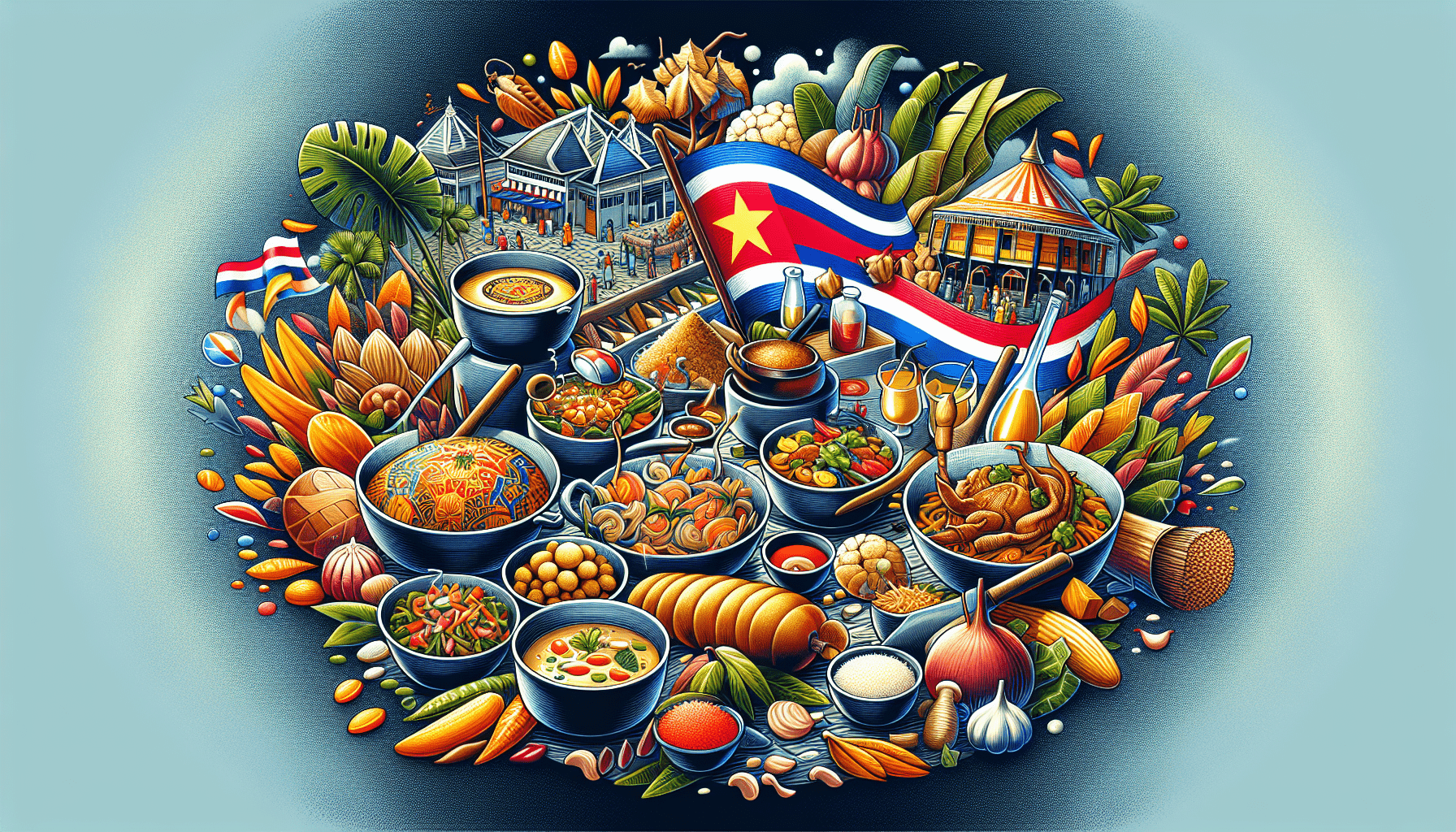Suriname, a small South American country nestled between Guyana, French Guiana, and Brazil, is a hidden gem when it comes to culinary delights. From traditional dishes rooted in African, Indian, Javanese, and Indigenous cultures to fusion creations influenced by Dutch and Chinese cuisines, Surinamese flavors are a vibrant medley of diverse tastes and aromas. In this article, you’ll embark on a delectable journey through Suriname’s rich culinary heritage, exploring mouth-watering dishes that reflect the country’s multicultural essence. Prepare to tantalize your taste buds and discover the hidden treasures of Surinamese cuisine.

Introduction
Suriname, a small country on the northeastern coast of South America, is known for its rich culinary heritage. This diverse nation is home to a fusion of cultures, which is reflected in its vibrant and eclectic cuisine. Surinamese dishes are a delightful mix of flavors and influences, drawing inspiration from various ethnic groups such as the Indigenous people, Africans, Asians, and Europeans. Exploring the culinary world of Suriname is like embarking on a culinary adventure, where you can discover the unique fusion of flavors and techniques that make this country’s cuisine truly special.
1. Traditional Surinamese Dishes
One cannot delve into the world of Surinamese cuisine without mentioning some of the traditional dishes that have become staples in the country. Roti, a popular dish in Suriname, is a flatbread often filled with curried vegetables, potatoes, and a choice of protein such as chicken, goat, or shrimp. This versatile dish is enjoyed by many Surinamese people and has become a favorite in other parts of the world as well.
Pom is another unique dish with African roots that has found its way into Surinamese cuisine. It is made with oven-baked or stewed taro root and various meats, such as chicken or salted codfish. The flavors of Pom are complex and tantalizing, with a perfect blend of sweet and savory notes.
Saoto Soup is a Javanese delicacy that has become a beloved comfort food in Suriname. This flavorful soup is made with chicken, bean sprouts, fried potatoes, and boiled eggs, all served in a savory broth. The combination of ingredients creates a hearty and satisfying dish that warms the soul.
Bami, Suriname’s version of fried noodles, is also a well-loved dish in the country. Influenced by Asian cuisines, particularly Chinese and Indonesian, Bami is often prepared with vegetables, meat, and a variety of spices. This dish is a testament to the multicultural nature of Suriname and how it embraces different culinary traditions.
2. Influences from Indigenous People
The Indigenous people of Suriname have had a significant impact on the country’s cuisine, particularly in the use of cassava. Cassava, a starchy root vegetable, is a staple in Surinamese cuisine. It is transformed into various dishes, such as cassava bread, cassava cake, and cassava fries. The Indigenous people have passed down their traditional methods of processing and cooking cassava, ensuring that this important ingredient remains central to Surinamese dishes.
In addition to cassava, the Indigenous people of Suriname are also skilled in various preparation methods for meat and fish. Smoking, grilling, and drying are common techniques used to preserve and enhance the flavors of meats like venison and fish from the rivers and coastlines of Suriname. These methods have been incorporated into Surinamese cuisine, adding depth and complexity to the dishes.
3. African Influences
African influences can be found throughout Surinamese cuisine, and one of the prominent ingredients that stem from this influence is okra. Okra, a popular vegetable in African cooking, has become an essential part of Surinamese dishes. It is often used in stews and soups, adding a unique texture and flavor to the dish. The sliminess of okra is appreciated by many Surinamese people, as it gives a silky quality to the various dishes it is used in.
Tjauw Min is another Surinamese dish that showcases the country’s take on Afro-Caribbean cuisine. This noodle dish is influenced by Chinese and African culinary traditions. Tjauw Min typically consists of stir-fried noodles, mixed with a variety of vegetables, meats, and spices. It is a harmonious blend of flavors and textures, representing the diverse cultural influences on Surinamese cuisine.

4. Asian Influences
The Asian influence on Surinamese cuisine is undeniable, as evident in the prevalence of Chinese and Indian flavors. Chinese immigrants brought their culinary skills and ingredients to Suriname, resulting in a wide range of Chinese-inspired dishes. Chinese cuisine has become an integral part of Surinamese culture, with dishes like bami, nasi, and roast pork being popular choices among locals.
Indian flavors have also made their mark in Surinamese cuisine, thanks to the Indian immigrants who arrived in the country. Curry dishes, such as chicken curry, beef curry, and vegetarian curries, are commonly enjoyed in Suriname. Indian spices and cooking techniques have been embraced by Surinamese people, adding depth and complexity to their traditional dishes.
5. European Influences
European influences in Surinamese cuisine can be traced back to the colonial era when Suriname was a Dutch colony. Dutch culinary traditions have left a lasting impact on Surinamese dishes, and ingredients like potatoes and peanuts became popular additions to the local cuisine. Surinamese stews often feature potatoes as a hearty component, while peanuts are used in sauces and marinades, adding a unique nutty flavor to the dishes.
In addition to Dutch influence, Surinamese cuisine has also been influenced by Portuguese and Spanish flavors. The introduction of ingredients like tomatoes, onions, and garlic into Surinamese cooking can be attributed to these European influences, enhancing the depth and complexity of flavors in traditional Surinamese dishes.
6. Fusion of Flavors
One of the most exciting aspects of Surinamese cuisine is the fusion of flavors that result from the blending of different cultural influences. Surinamese dishes are a testament to the harmonious coexistence of various ethnic groups, with each contributing their own distinct flavors and techniques. The blending of Indigenous, African, Asian, and European influences creates a culinary landscape that is truly unique to Suriname.
This fusion can be seen in dishes like Nasi Goreng, which combines Indonesian and Chinese flavors, and Pom, which incorporates African and European ingredients and cooking techniques. These dishes exemplify the creativity and adaptability of Surinamese cuisine, resulting in one-of-a-kind flavors that cannot be found anywhere else.
7. Spices and Seasonings
Surinamese cuisine is known for its bold and flavorful spices and seasonings. Traditional Surinamese spices include masala, a blend of various spices like cumin, coriander, and turmeric, which is influenced by Indian and Indonesian cuisines. Masala is often used to season meats, vegetables, and rice, adding a fragrant and aromatic element to the dishes.
Imported spices are also widely used in Surinamese cuisine, thanks to the country’s history of trade and cultural exchange. Spices like cinnamon, nutmeg, and cloves, which are associated with European and Asian cuisines, find their way into Surinamese dishes, adding depth and complexity to the flavors.
8. Street Food Culture
Suriname’s street food culture is vibrant and diverse, offering a wide array of delectable treats for locals and tourists alike. The streets of Suriname are lined with food stalls and carts, each boasting its own specialty. From savory snacks like bara, a deep-fried dough stuffed with spiced potatoes or chicken, to sweet delights like gulgula, a fried dough ball coated in syrup, Suriname’s street food scene is a paradise for food enthusiasts.
Must-try street food dishes in Suriname include roti rolls, where a delicious filling of curried vegetables, chicken, or shrimp is wrapped in warm roti bread, and broodje bakkeljauw, a sandwich filled with salted codfish that has been cooked with onions, tomatoes, and spices. These street food delights allow you to experience the authentic flavors of Suriname while immersing yourself in the lively atmosphere of the local food scene.
Conclusion
In conclusion, the culinary heritage of Suriname is a true celebration of diversity and cultural fusion. The country’s rich history and the influences of various ethnic groups have shaped Surinamese cuisine into a vibrant tapestry of flavors, textures, and techniques. Whether you are indulging in traditional dishes, savoring the fusion of different flavors, or exploring the colorful street food scene, Surinamese cuisine promises a culinary adventure like no other. So, embark on a journey to discover the diverse and eclectic flavors of Surinamese cuisine and let your taste buds be delighted by the unique combinations and harmonious blends that make this cuisine truly special.